Restful framework【第六篇】认证组件
基本用法
-认证功能
1 写一个类,继承BaseAuthentication
2 def authenticate(self,request) ,记住传request对象
-如果验证通过,返回None或者两个值
3 在视图类中使用:(不要加括号)
authentication_classes=[AuthLogin]
-认证功能的局部配置
-authentication_classes=[AuthLogin]
-认证功能的全局配置,在settings.py中配置
-REST_FRAMEWORK={
"DEFAULT_AUTHENTICATION_CLASSES":["app01.auth.AuthLogin",]
}
-全局使用的局部禁用:
authentication_classes = []
简单实例
settings
先创建一个project和一个app(我这里命名为API)
首先要在settings的app中添加
INSTALLED_APPS = [
'rest_framework',
]
url
from django.contrib import admin
from django.urls import path
from API.views import AuthView urlpatterns = [
path('admin/', admin.site.urls),
path('api/v1/auth/',AuthView.as_view()),
]
models
一个保存用户的信息
一个保存用户登录成功后的token
from django.db import models class UserInfo(models.Model):
USER_TYPE = (
(1,'普通用户'),
(2,'VIP'),
(3,'SVIP')
) user_type = models.IntegerField(choices=USER_TYPE)
username = models.CharField(max_length=32)
password = models.CharField(max_length=64) class UserToken(models.Model):
user = models.OneToOneField(UserInfo,on_delete=models.CASCADE)
token = models.CharField(max_length=64)
views
用户登录(返回token并保存到数据库)
from django.shortcuts import render
from django.http import JsonResponse
from rest_framework.views import APIView
from API import models def md5(user):
import hashlib
import time
#当前时间,相当于生成一个随机的字符串
ctime = str(time.time())
m = hashlib.md5(bytes(user,encoding='utf-8'))
m.update(bytes(ctime,encoding='utf-8'))
return m.hexdigest() class AuthView(object):
def post(self,request,*args,**kwargs):
ret = {'code':1000,'msg':None}
try:
user = request._request.POST.get('username')
pwd = request._request.POST.get('password')
obj = models.UserInfo.objects.filter(username=user,password=pwd).first()
if not obj:
ret['code'] = 1001
ret['msg'] = '用户名或密码错误'
#为用户创建token
token = md5(user)
#存在就更新,不存在就创建
models.UserToken.objects.update_or_create(user=obj,defaults={'token':token})
ret['token'] = token
except Exception as e:
ret['code'] = 1002
ret['msg'] = '请求异常'
return JsonResponse(ret)
利用postman发请求
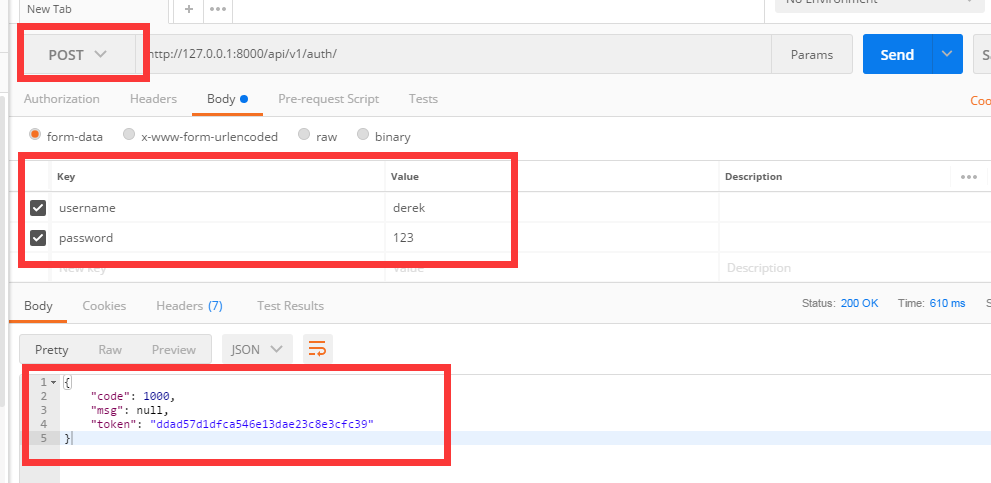
如果用户名和密码正确的话 会生成token值,下次该用户再登录时,token的值就会更新
数据库中可以看到token的值

当用户名或密码错误时,抛出异常
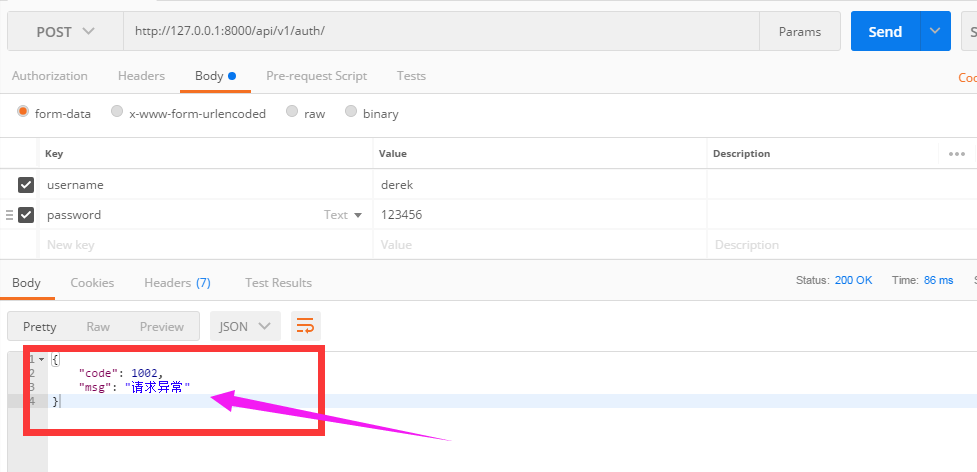
添加认证
基于上面的例子,添加一个认证的类
url
path('api/v1/order/',OrderView.as_view()),
views
from django.shortcuts import render,HttpResponse
from django.http import JsonResponse
from rest_framework.views import APIView
from API import models
from rest_framework.request import Request
from rest_framework import exceptions
from rest_framework.authentication import BasicAuthentication ORDER_DICT = {
1:{
'name':'apple',
'price':15
},
2:{
'name':'dog',
'price':100
}
} def md5(user):
import hashlib
import time
#当前时间,相当于生成一个随机的字符串
ctime = str(time.time())
m = hashlib.md5(bytes(user,encoding='utf-8'))
m.update(bytes(ctime,encoding='utf-8'))
return m.hexdigest() class AuthView(object):
'''用于用户登录验证'''
def post(self,request,*args,**kwargs):
ret = {'code':1000,'msg':None}
try:
user = request._request.POST.get('username')
pwd = request._request.POST.get('password')
obj = models.UserInfo.objects.filter(username=user,password=pwd).first()
if not obj:
ret['code'] = 1001
ret['msg'] = '用户名或密码错误'
#为用户创建token
token = md5(user)
#存在就更新,不存在就创建
models.UserToken.objects.update_or_create(user=obj,defaults={'token':token})
ret['token'] = token
except Exception as e:
ret['code'] = 1002
ret['msg'] = '请求异常'
return JsonResponse(ret) class Authentication(APIView):
'''认证'''
def authenticate(self,request):
token = request._request.GET.get('token')
token_obj = models.UserToken.objects.filter(token=token).first()
if not token_obj:
raise exceptions.AuthenticationFailed('用户认证失败')
#在rest framework内部会将这两个字段赋值给request,以供后续操作使用
return (token_obj.user,token_obj) def authenticate_header(self, request):
pass class OrderView(APIView):
'''订单相关业务''' authentication_classes = [Authentication,] #添加认证
def get(self,request,*args,**kwargs):
#request.user
#request.auth
ret = {'code':1000,'msg':None,'data':None}
try:
ret['data'] = ORDER_DICT
except Exception as e:
pass
return JsonResponse(ret)
用postman发get请求
请求的时候没有带token,可以看到会显示“用户认证失败”
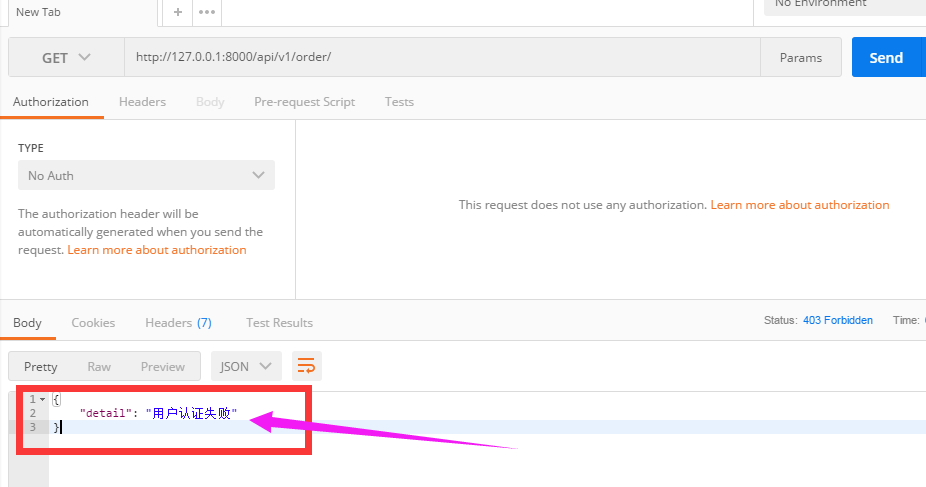
这样就达到了认证的效果,django-rest-framework的认证是怎么实现的呢,下面基于这个例子来剖析drf的源码。
drf的认证源码分析
源码流程图
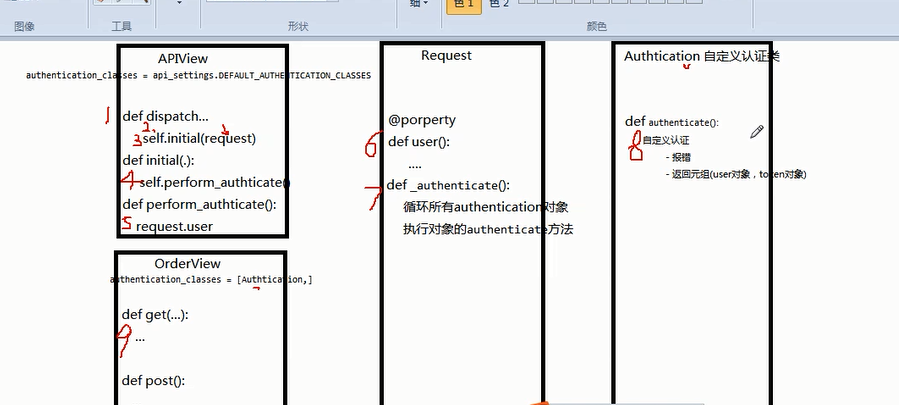
请求先到dispatch
dispatch()主要做了两件事
- 封装request
- 认证
具体看我写的代码里面的注释
def dispatch(self, request, *args, **kwargs):
"""
`.dispatch()` is pretty much the same as Django's regular dispatch,
but with extra hooks for startup, finalize, and exception handling.
"""
self.args = args
self.kwargs = kwargs
#对原始request进行加工,丰富了一些功能
#Request(
# request,
# parsers=self.get_parsers(),
# authenticators=self.get_authenticators(),
# negotiator=self.get_content_negotiator(),
# parser_context=parser_context
# )
#request(原始request,[BasicAuthentications对象,])
#获取原生request,request._request
#获取认证类的对象,request.authticators
#1.封装request
request = self.initialize_request(request, *args, **kwargs)
self.request = request
self.headers = self.default_response_headers # deprecate? try:
#2.认证
self.initial(request, *args, **kwargs) # Get the appropriate handler method
if request.method.lower() in self.http_method_names:
handler = getattr(self, request.method.lower(),
self.http_method_not_allowed)
else:
handler = self.http_method_not_allowed response = handler(request, *args, **kwargs) except Exception as exc:
response = self.handle_exception(exc) self.response = self.finalize_response(request, response, *args, **kwargs)
return self.response
reuqest
(1)initialize_request()
可以看到initialize()就是封装原始request
def initialize_request(self, request, *args, **kwargs):
"""
Returns the initial request object.
"""
parser_context = self.get_parser_context(request) return Request(
request,
parsers=self.get_parsers(),
authenticators=self.get_authenticators(), #[BasicAuthentication(),],把对象封装到request里面了
negotiator=self.get_content_negotiator(), parser_context=parser_context )
(2)get_authenticators()
通过列表生成式,返回对象的列表
def get_authenticators(self):
"""
Instantiates and returns the list of authenticators that this view can use.
"""
return [auth() for auth in self.authentication_classes]
(3)authentication_classes
APIView里面有个 authentication_classes 字段
可以看到默认是去全局的配置文件找(api_settings)
class APIView(View):
# The following policies may be set at either globally, or per-view.
renderer_classes = api_settings.DEFAULT_RENDERER_CLASSES
parser_classes = api_settings.DEFAULT_PARSER_CLASSES
authentication_classes = api_settings.DEFAULT_AUTHENTICATION_CLASSES
throttle_classes = api_settings.DEFAULT_THROTTLE_CLASSES
permission_classes = api_settings.DEFAULT_PERMISSION_CLASSES
content_negotiation_class = api_settings.DEFAULT_CONTENT_NEGOTIATION_CLASS
metadata_class = api_settings.DEFAULT_METADATA_CLASS
versioning_class = api_settings.DEFAULT_VERSIONING_CLASS
认证
self.initial(request, *args, **kwargs)
def dispatch(self, request, *args, **kwargs):
"""
`.dispatch()` is pretty much the same as Django's regular dispatch,
but with extra hooks for startup, finalize, and exception handling.
"""
self.args = args
self.kwargs = kwargs
#对原始request进行加工,丰富了一些功能
#Request(
# request,
# parsers=self.get_parsers(),
# authenticators=self.get_authenticators(),
# negotiator=self.get_content_negotiator(),
# parser_context=parser_context
# )
#request(原始request,[BasicAuthentications对象,])
#获取原生request,request._request
#获取认证类的对象,request.authticators
#1.封装request
request = self.initialize_request(request, *args, **kwargs)
self.request = request
self.headers = self.default_response_headers # deprecate? try:
#2.认证
self.initial(request, *args, **kwargs) # Get the appropriate handler method
if request.method.lower() in self.http_method_names:
handler = getattr(self, request.method.lower(),
self.http_method_not_allowed)
else:
handler = self.http_method_not_allowed response = handler(request, *args, **kwargs) except Exception as exc:
response = self.handle_exception(exc) self.response = self.finalize_response(request, response, *args, **kwargs)
return self.response
(1)initial()
主要看 self.perform_authentication(request),实现认证
def initial(self, request, *args, **kwargs):
"""
Runs anything that needs to occur prior to calling the method handler.
"""
self.format_kwarg = self.get_format_suffix(**kwargs) # Perform content negotiation and store the accepted info on the request
neg = self.perform_content_negotiation(request)
request.accepted_renderer, request.accepted_media_type = neg # Determine the API version, if versioning is in use.
version, scheme = self.determine_version(request, *args, **kwargs)
request.version, request.versioning_scheme = version, scheme # Ensure that the incoming request is permitted
#3.实现认证
self.perform_authentication(request)
self.check_permissions(request)
self.check_throttles(request)
(2)perform_authentication()
调用了request.user
def perform_authentication(self, request):
"""
Perform authentication on the incoming request. Note that if you override this and simply 'pass', then authentication
will instead be performed lazily, the first time either
`request.user` or `request.auth` is accessed.
"""
request.user
(3)user
request.user的request的位置

点进去可以看到Request有个user方法,加 @property 表示调用user方法的时候不需要加括号“user()”,可以直接调用:request.user
@property
def user(self):
"""
Returns the user associated with the current request, as authenticated
by the authentication classes provided to the request.
"""
if not hasattr(self, '_user'):
with wrap_attributeerrors():
#获取认证对象,进行一步步的认证
self._authenticate()
return self._user
(4)_authenticate()
循环所有authenticator对象
def _authenticate(self):
"""
Attempt to authenticate the request using each authentication instance
in turn.
"""
#循环认证类的所有对象
#执行对象的authenticate方法
for authenticator in self.authenticators:
try:
#执行认证类的authenticate方法
#这里分三种情况
#1.如果authenticate方法抛出异常,self._not_authenticated()执行
#2.有返回值,必须是元组:(request.user,request.auth)
#3.返回None,表示当前认证不处理,等下一个认证来处理
user_auth_tuple = authenticator.authenticate(self)
except exceptions.APIException:
self._not_authenticated()
raise if user_auth_tuple is not None:
self._authenticator = authenticator
self.user, self.auth = user_auth_tuple
return self._not_authenticated()
返回值就是例子中的:
token_obj.user-->>request.user
token_obj-->>request.auth
#在rest framework内部会将这两个字段赋值给request,以供后续操作使用
return (token_obj.user,token_obj) #例子中的return
当都没有返回值,就执行self._not_authenticated(),相当于匿名用户,没有通过认证
def _not_authenticated(self):
"""
Set authenticator, user & authtoken representing an unauthenticated request. Defaults are None, AnonymousUser & None.
"""
self._authenticator = None if api_settings.UNAUTHENTICATED_USER:
self.user = api_settings.UNAUTHENTICATED_USER() #AnonymousUser匿名用户
else:
self.user = None if api_settings.UNAUTHENTICATED_TOKEN:
self.auth = api_settings.UNAUTHENTICATED_TOKEN() #None
else:
self.auth = None
面向对象知识:
子类继承 父类,调用方法的时候:
- 优先去自己里面找有没有这个方法,有就执行自己的
- 只有当自己里面没有这个方法的时候才会去父类找
因为authenticate方法我们自己写,所以当执行authenticate()的时候就是执行我们自己写的认证
父类中的authenticate方法
def authenticate(self, request):
return (self.force_user, self.force_token)
我们自己写的
class Authentication(APIView):
'''用于用户登录验证'''
def authenticate(self,request):
token = request._request.GET.get('token')
token_obj = models.UserToken.objects.filter(token=token).first()
if not token_obj:
raise exceptions.AuthenticationFailed('用户认证失败')
#在rest framework内部会将这两个字段赋值给request,以供后续操作使用
return (token_obj.user,token_obj)
认证的流程就是上面写的,弄懂了原理,再写代码就更容易理解为什么了。
配置文件
继续解读源码

默认是去全局配置文件中找,所以我们应该在settings.py中配置好路径
api_settings源码
api_settings = APISettings(None, DEFAULTS, IMPORT_STRINGS) def reload_api_settings(*args, **kwargs):
setting = kwargs['setting']
if setting == 'REST_FRAMEWORK':
api_settings.reload()
setting中‘REST_FRAMEWORK’中找
全局配置方法:
API文件夹下面新建文件夹utils,再新建auth.py文件,里面写上认证的类
settings.py
#设置全局认证
REST_FRAMEWORK = {
"DEFAULT_AUTHENTICATION_CLASSES":['API.utils.auth.Authentication',] #里面写你的认证的类的路径
}
auth.py
# API/utils/auth.py from rest_framework import exceptions
from API import models class Authentication(object):
'''用于用户登录验证'''
def authenticate(self,request):
token = request._request.GET.get('token')
token_obj = models.UserToken.objects.filter(token=token).first()
if not token_obj:
raise exceptions.AuthenticationFailed('用户认证失败')
#在rest framework内部会将这两个字段赋值给request,以供后续操作使用
return (token_obj.user,token_obj) def authenticate_header(self, request):
pass
在settings里面设置的全局认证,所有业务都需要经过认证,如果想让某个不需要认证,只需要在其中添加下面的代码:
authentication_classes = [] #里面为空,代表不需要认证

from django.shortcuts import render,HttpResponse
from django.http import JsonResponse
from rest_framework.views import APIView
from API import models
from rest_framework.request import Request
from rest_framework import exceptions
from rest_framework.authentication import BasicAuthentication ORDER_DICT = {
1:{
'name':'apple',
'price':15
},
2:{
'name':'dog',
'price':100
}
} def md5(user):
import hashlib
import time
#当前时间,相当于生成一个随机的字符串
ctime = str(time.time())
m = hashlib.md5(bytes(user,encoding='utf-8'))
m.update(bytes(ctime,encoding='utf-8'))
return m.hexdigest() class AuthView(APIView):
'''用于用户登录验证''' authentication_classes = [] #里面为空,代表不需要认证 def post(self,request,*args,**kwargs):
ret = {'code':1000,'msg':None}
try:
user = request._request.POST.get('username')
pwd = request._request.POST.get('password')
obj = models.UserInfo.objects.filter(username=user,password=pwd).first()
if not obj:
ret['code'] = 1001
ret['msg'] = '用户名或密码错误'
#为用户创建token
token = md5(user)
#存在就更新,不存在就创建
models.UserToken.objects.update_or_create(user=obj,defaults={'token':token})
ret['token'] = token
except Exception as e:
ret['code'] = 1002
ret['msg'] = '请求异常'
return JsonResponse(ret) class OrderView(APIView):
'''订单相关业务''' def get(self,request,*args,**kwargs):
# self.dispatch
#request.user
#request.auth
ret = {'code':1000,'msg':None,'data':None}
try:
ret['data'] = ORDER_DICT
except Exception as e:
pass
return JsonResponse(ret)

API/view.py代码
再测试一下我们的代码
不带token发请求

带token发请求
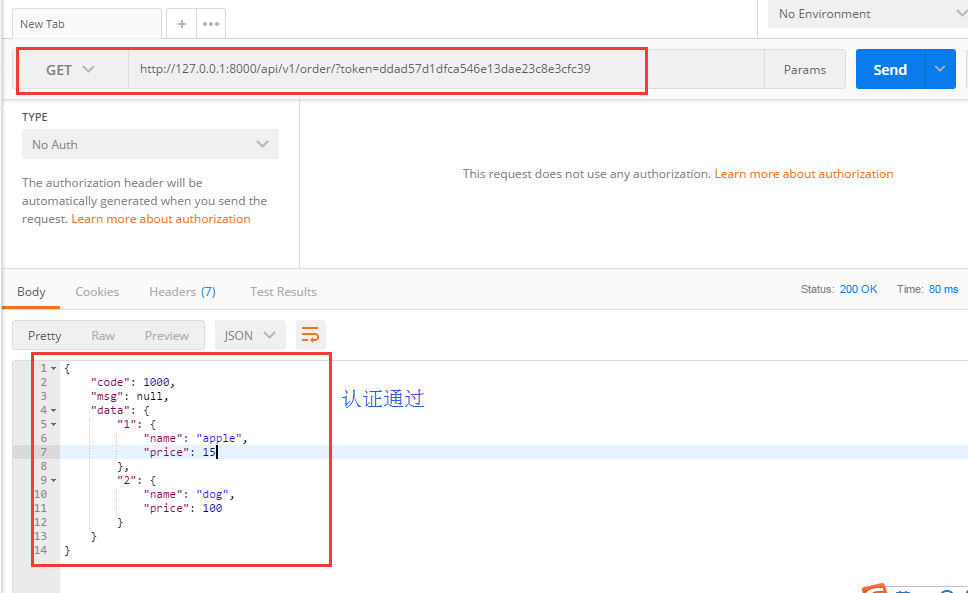
drf的内置认证
rest_framework里面内置了一些认证,我们自己写的认证类都要继承内置认证类 "BaseAuthentication"
BaseAuthentication源码:
class BaseAuthentication(object):
"""
All authentication classes should extend BaseAuthentication.
""" def authenticate(self, request):
"""
Authenticate the request and return a two-tuple of (user, token).
"""
#内置的认证类,authenticate方法,如果不自己写,默认则抛出异常 (规范了接口,模拟其它语言接口的概念)
raise NotImplementedError(".authenticate() must be overridden.") def authenticate_header(self, request):
"""
Return a string to be used as the value of the `WWW-Authenticate`
header in a `401 Unauthenticated` response, or `None` if the
authentication scheme should return `403 Permission Denied` responses.
"""
#authenticate_header方法,作用是当认证失败的时候,返回的响应头
pass
修改自己写的认证类
自己写的Authentication必须继承内置认证类BaseAuthentication
# API/utils/auth/py from rest_framework import exceptions
from API import models
from rest_framework.authentication import BaseAuthentication class Authentication(BaseAuthentication):
'''用于用户登录验证'''
def authenticate(self,request):
token = request._request.GET.get('token')
token_obj = models.UserToken.objects.filter(token=token).first()
if not token_obj:
raise exceptions.AuthenticationFailed('用户认证失败')
#在rest framework内部会将这两个字段赋值给request,以供后续操作使用
return (token_obj.user,token_obj) def authenticate_header(self, request):
pass
其它内置认证类
rest_framework里面还内置了其它认证类,我们主要用到的就是BaseAuthentication,剩下的很少用到

总结
只要用了drf,post提交数据,就不需要csrf验证了,源码里对View用了禁用csrf
自己写认证类方法梳理
(1)创建认证类
- 继承BaseAuthentication --->>1.重写authenticate方法;2.authenticate_header方法直接写pass就可以(这个方法必须写)
(2)authenticate()返回值(三种)
- None ----->>>当前认证不管,等下一个认证来执行
- raise exceptions.AuthenticationFailed('用户认证失败') # from rest_framework import exceptions
- 有返回值元祖形式:(元素1,元素2) #元素1复制给request.user; 元素2复制给request.auth
(3)局部使用
- authentication_classes = [BaseAuthentication,]
(4)全局使用
#设置全局认证
REST_FRAMEWORK = {
"DEFAULT_AUTHENTICATION_CLASSES":['API.utils.auth.Authentication',]
}
源码流程
--->>dispatch
--封装request
---获取定义的认证类(全局/局部),通过列表生成式创建对象
---initial
----peform_authentication
-----request.user (每部循环创建的对象)
Restful framework【第六篇】认证组件的更多相关文章
- Django高级篇三。restful的解析器,认证组件,权限组件
一.rest=framework之解析器 1)解析器作用. 根据提交的数据.只解析某些特定的数据.非法数据不接收,为了系统安全问题 比如解析的数据格式有 有application/json,x-www ...
- Django-rest framework框架的三大认证组件
源码分析:三大认证组件的封装 组件的认证配置: 模型层:models.py class User(BaseModel): username = models.CharField(verbose_nam ...
- Restful framework【第二篇】APIView
安装djangorestframework 方式一:pip3 install djangorestframework 方式二:pycharm图形化界面安装 方式三:pycharm命令行下安装(装在当前 ...
- Restful framework【第一篇】RESTful 规范
什么是RESTful REST与技术无关,代表的是一种软件架构风格,REST是Representational State Transfer的简称,中文翻译为“表征状态转移” REST从资源的角度类审 ...
- Entity Framework 第六篇 分页查询
目前分页支持单表 , ) where TEntity : class { ) * size; var _reset = Get(filter, orderBy); total = _reset.Cou ...
- Restful framework【第九篇】分页器
基本使用 分页 -简单分页 page_size = api_settings.PAGE_SIZE :每页显示条数 page_query_param = 'page' :查询的页码数 page_size ...
- restful framework之认证组件
一.认证介绍 只有认证通过的用户才能访问指定的url地址,比如:查询课程信息,需要登录之后才能查看,没有登录,就不能查看,这时候需要用到认证组件 二.局部使用 (1)models层: class Us ...
- rest framework认证组件和django自带csrf组件区别详解
使用 Django 中的 csrf 处理 Django中有一个django.middleware.csrf.CsrfViewMiddleware中间件提供了全局的csrf检查.它的原理是在<fo ...
- NHibernate 组件基础 (第六篇)
NHibernate 组件基础 (第六篇) 一.组件简介 组件(Component)可以理解为被一个对象所包含的对象而持久化,而并非一个实体.简单说来,假如数据库有FirstName,LastName ...
- drf:restful概念,类继承关系,drf请求封装,drf请求流程,版本控制组件,认证组件(token),权限组件
1.restful规范 resfful规范的概念最重要: 是一套规范,规则,用于程序之间进行数据交换的约定. 他规定了一些协议,对我们感受最直接的就是,以前写增删改查的时候需要些四个视图寒素,rest ...
随机推荐
- react的props验证
Props 验证使用 propTypes,它可以保证我们的应用组件被正确使用,React.PropTypes 提供很多验证器 (validator) 来验证传入数据是否有效. 当向 props 传入无 ...
- c#如何判断字符串是否含中文
如代码: static bool ContainChinese(string input) { string pattern = "[\u4e00-\u9fbb]"; return ...
- [ Learning ] Design Pattens
1. 单例2. 模板3. 代理,装饰 (代理和装饰的区别)4. 状态
- codeforces 975C Valhalla Siege
题意: 有n个巫师站成一列,每个巫师有自己的血量. 一个人射箭攻击他们,每次造成若干点伤害,巫师按照给定的顺序承受伤害,如果伤害大了,那么死掉,伤害落到下一个巫师身上. 如果一轮攻击之后,所有的巫师都 ...
- 基于word2vec训练词向量(二)
转自:http://www.tensorflownews.com/2018/04/19/word2vec2/ 一.基于Hierarchical Softmax的word2vec模型的缺点 上篇说了Hi ...
- Java国际化号码验证方法,国内手机号正则表达式
Java国际化号码验证方法,国内手机号正则表达式 中国电信号段 133.149.153.173.177.180.181.189.199 中国联通号段 130.131.132.145.155.156.1 ...
- AELF(ELF)区块链项目介绍
AELF(ELF)区块链项目介绍,Aelf在交易所上的名称是ELF,最近涨了不少了,可以长期关注逢低建仓,根据自身情况可以适当轻仓配置点.AELF总结下来就是希望打造一个B2B的区块链开放式OS系统. ...
- session(概念、session对象的获取、删除、验证)
# 1.session(会话)是什么? 服务器为了保存用户状态而创建的一个特殊的对象. 注: 当浏览器访问服务器时,服务器会创建一个session对象(该对象有一个唯一的id,一般称之为session ...
- 管理mycat命令详解
mycat监听两个端口,分别为8066和9066:mycat服务默认的数据端口是8066,而9066端口则是mycat管理端口,用于管理mycat的整个集群状态.监听的端口可以在server.xml配 ...
- scrapy 自定义图片路径保存,并存到数据库中
scrapy中有个自带的pipeline工具,ImagesPipeline,可以专门用来储存图片到本地. 但默认储存地址无法配置,所以我们需要写一个自己的pipeline用于储存图片. 先分析一下我们 ...
